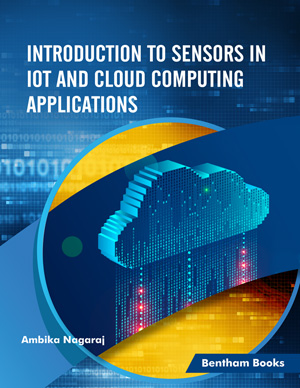Introduction to Sensors
Page: 1-54 (54)
Author: Ambika Nagaraj
DOI: 10.2174/9789811479359121010005
PDF Price: $30
Abstract
Sensors are tiny, low-cost devices engaging themselves to monitor the environment in many applications. Their assembly is programmed to gather sensory information and move data to the predefined destination. The readings received by the sensors are gathered by the gateway node and redirected to the data processing module. They further parse the directions and send the information to the Sink node. This chapter details the working of these devices in various applications and the challenges faced by them. It also provides an overview of the book. Like any domain or sensors that have shortcomings are worked upon to provide flexibility and ease.
Introduction to Internet-of-Things (IoT)
Page: 55-69 (15)
Author: Ambika Nagaraj
DOI: 10.2174/9789811479359121010006
PDF Price: $30
Abstract
The sensors are tiny devices used to sense the environment or track any object of interest. These are self-configuring devices aiding by minimizing human efforts. Intelligent sensors aggregate resulting in IoT segments. They convert the present reality variable estimated into a digital information stream for transmission to a gateway. Internet of Things (IoT) applications used for city foundations, plants, or wearables utilize enormous varieties of sensors gathering information to transmit over the Internet to a local, cloud-based, and figuring asset. The chapter details the architecture and working of IoT, applications, use cases, challenges of the technology, and future directions. It also highlights the essence of sensors in building an IoT device.
Mobile Cloud Computing
Page: 70-100 (31)
Author: Ambika Nagaraj
DOI: 10.2174/9789811479359121010007
PDF Price: $30
Abstract
Mobile cloud computing (MCC) is the administrations of distributed computing. The facilitation is available to a cell phone or any hand-versatile framework. Portable processing coordinates with distributed computing on account of the fundamental attributes of the cloud model. Some examples include on-request selfadministration, asset pooling, quick flexibility, and estimated administrations. Portable Sensor-cloud collects the readings in an unsupervised environment and provides the queried data to the respective clients. This chapter provides a vision into the taxonomy of the mobile cloud system, its security issues, management issues, advantages, applications, challenges, and future directions.
Fog Computing
Page: 101-117 (17)
Author: Ambika Nagaraj
DOI: 10.2174/9789811479359121010008
PDF Price: $30
Abstract
Fog processing is a dispersed computation worldview that goes about as a moderate layer in the middle of Cloud datacenters and IoT gadgets/sensors. It offers calculation, systems administration, and storerooms to Cloud-based administrations to stretch out nearer to the IoT gadgets/sensors. Since Cloud datacenters are geologically intensive, they frequently neglect to manage capacity and preparing requests of billions of geo-dispersed IoT gadgets/sensors. Accordingly, the clogged system experiences high inactivity in administration conveyance and low quality of Service (QoS). This chapter discusses the taxonomy, challenges, and future directions.
Integration of IoT and Cloud Computing
Page: 118-136 (19)
Author: Ambika Nagaraj
DOI: 10.2174/9789811479359121010009
PDF Price: $30
Abstract
The Internet of Things (IoT) is a self-configuring device interconnected in a dynamic and worldwide system foundation. Such devices actualize the monitoring process by little things assistance deployed in the environment. However, they carry out their tasks with restricted stockpiling and handling limits. Other concerns include activities related to unwavering quality, execution, security, and protection. Cloud has boundless abilities with ample capacity and data preparation. It has substantially more experienced innovation for handling the majority of the IoT issues. A novel IT worldview in which Cloud and IoT are two reciprocal advances consolidated and relied upon to build the future. The following chapter summarizes the integrated system, its applications and contribution. It also discusses some of the open issues of the technology.
Introduction
Introduction to Sensors in IoT and Cloud Computing Applications provides information about sensors and their applications. Readers are first introduced to the concept of small instruments and their application as sensors. The chapters which follow explain Internet of Things (IoT) architecture while providing notes on the implementation, demonstration and related issues of IoT systems. The book continues to explore the topic by providing information about sensor-cloud infrastructure, mobile cloud, fog computing (an extension of cloud computing that takes cloud computing to the cutting-edge of networking where data is produced) and integration of IoT devices with cloud computing. The book also presents notes on the taxonomy of fog-computing systems. The six chapters in this book provide essential information for general readers, and students of computer science to understand the basics of cloud computing networks, related concepts and applications.






















